Former Home of Mary Baker Strong - An Active Anti-Suffragist
Introduction
Text-to-speech Audio
Mary Baker Strong (MIT Class of 1897) purchased 258 Beacon Street in 1892 and lived there until 1897, when she moved to Cambridge. The June 1909 Cambridge Chronicle announced, "Cambridge is not only the home of some strong woman suffragists but also of some equally active anti-woman suffragists. Mrs. Charles P. Strong, of 24 Concord Avenue, is corresponding secretary of the Massachusetts association opposed to the further extension of suffrage to women." 17 Founded in 1895, MAOFESW was the oldest and strongest anti-woman suffrage organization in the United States. Mary's active involvement through 1921, including her role as the corresponding secretary, contributions to the MAOFESW annual journal, The Remonstrance, and public anti-suffrage advocacy, is a testament to her unwavering dedication and influence within the organization.2,10
Images
Mabel Delano (Clapp) Lord, left, poses next to Mary (Baker) Strong in front of a stone wall.
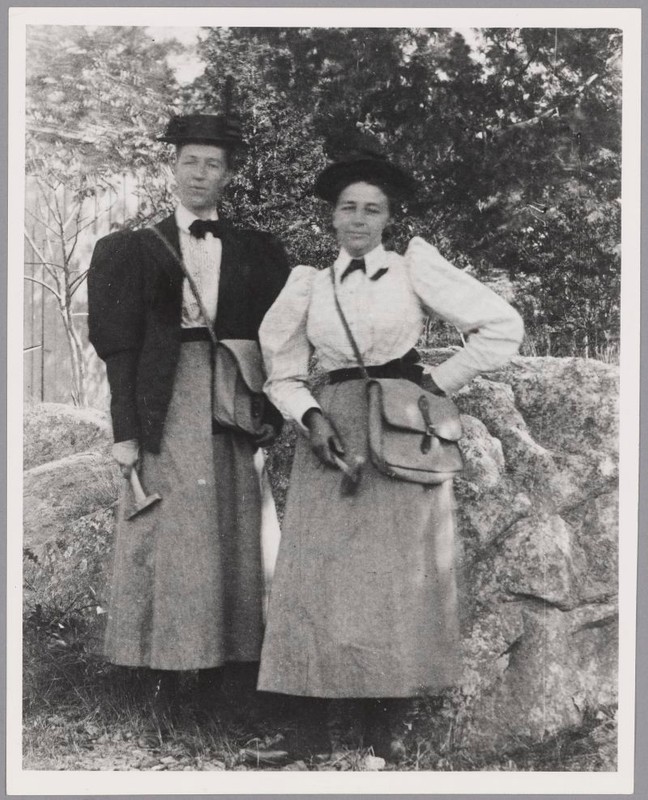
Torn black and white photograph of William T. Sedgwick teaching students in a biology laboratory. Sedgwick stands at the chalkboard as the mostly male students look on. One female student can be seen in the foreground. Boston Campus 1890s
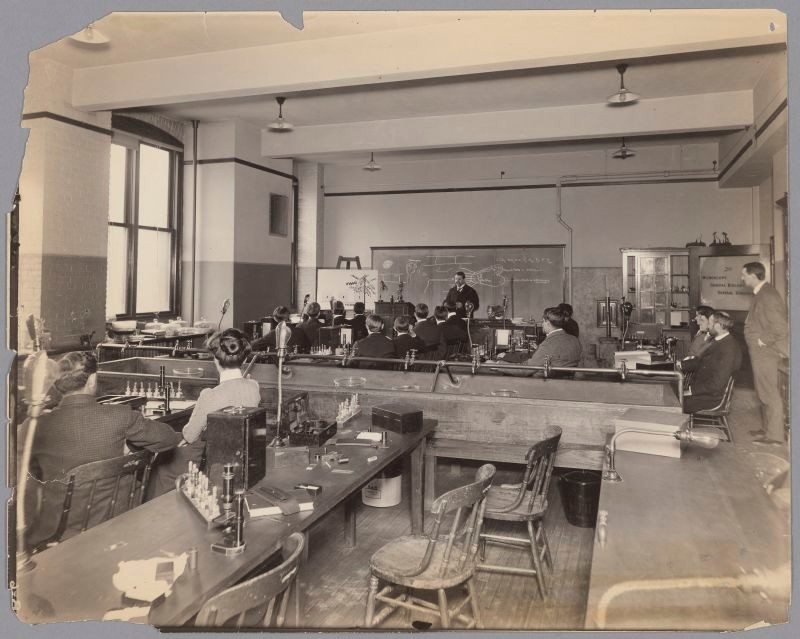
258-260 Beacon Street, Boston, Massachusetts. 1941
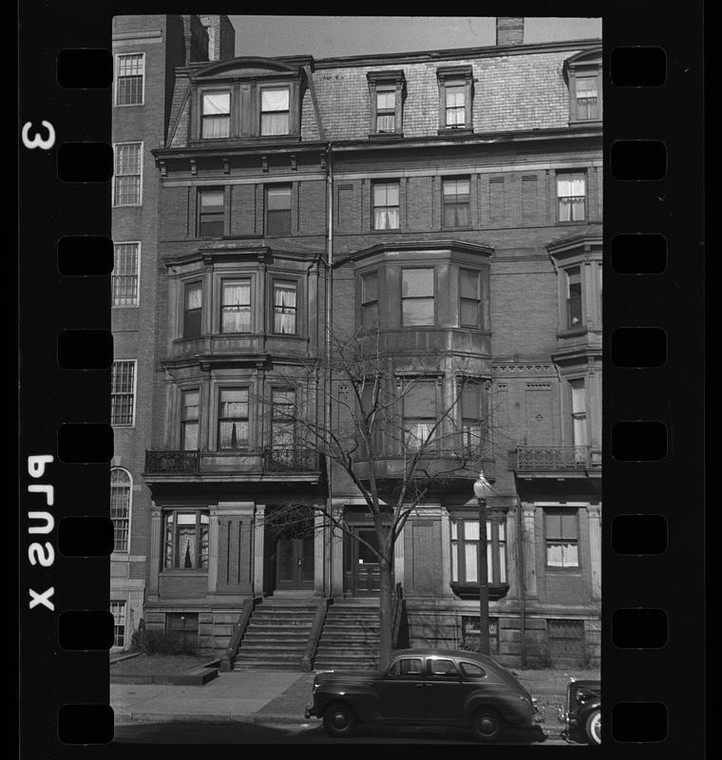
A Reason a Day Why Women Should Not Vote
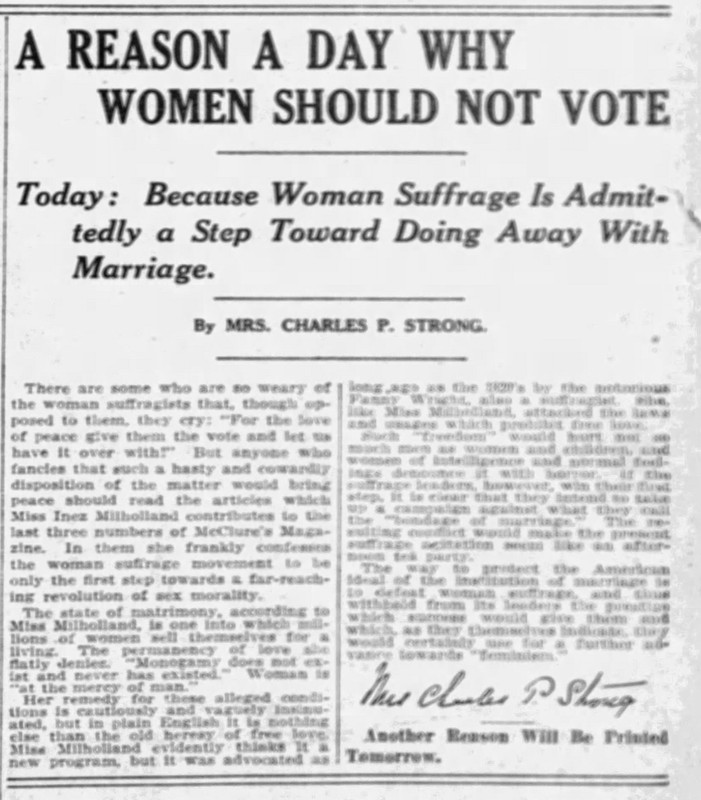
A Reason a Day Why Women Should Not Vote
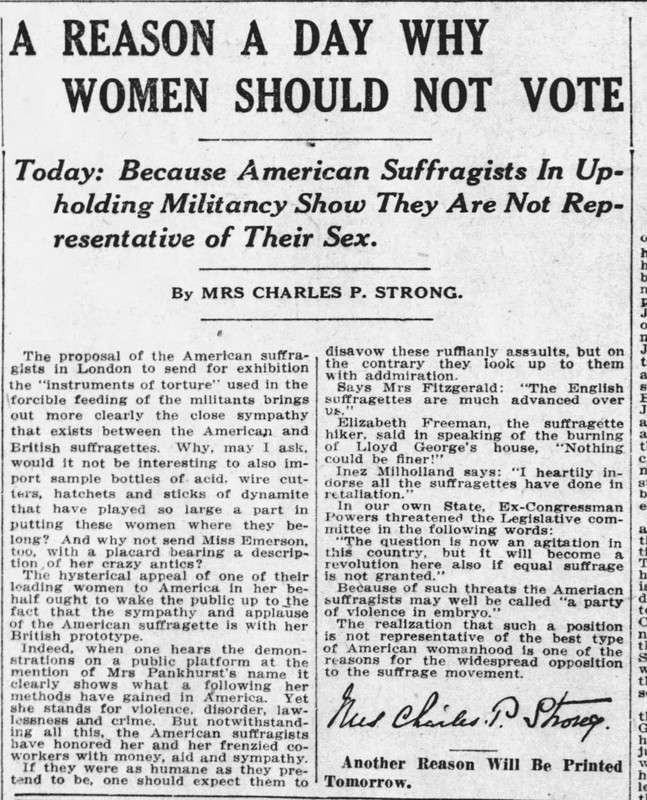
In an advertisement targeted to Harvard first-years and so-signed by Mary Strong, "a plea to vote against woman suffrage" in November's election. The average age of first-years was 18.5 yrs, but you had to be 21 to vote.
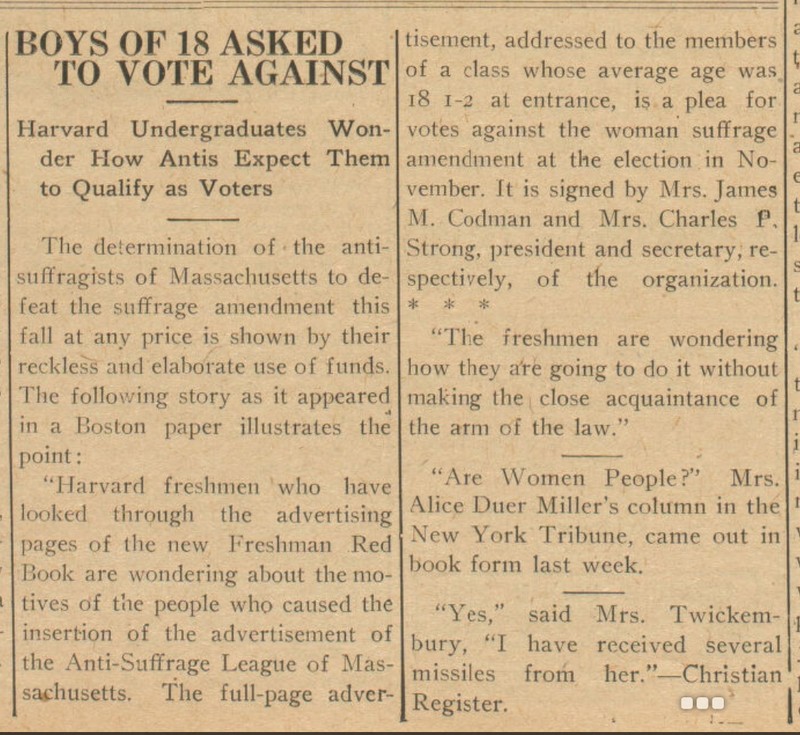
Anti-Suffrage Association Ad that ran in Massachusetts papers prior to the 1915 Women's Suffrage ballot measure
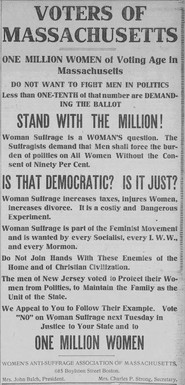
Anti-Suffrage Association Ad that ran in The Boston Globe on the eve of the 1915 Women's Suffrage ballot measure

Proving That Women Are in Politics
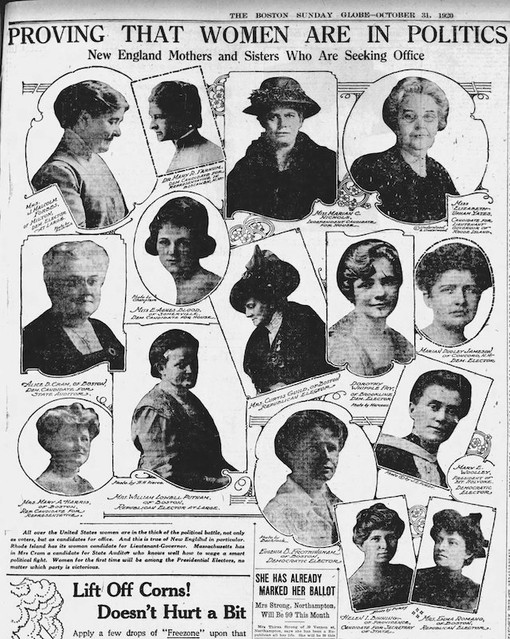
Backstory and Context
Text-to-speech Audio
Following the loss of her husband in 1893, Mary Baker Strong embarked on a new chapter of her life. She enrolled at the Massachusetts Institute of Technology (MIT) from 1895 to 1897, where she studied Geology and Sociology. During this time, she likely crossed paths with Professor William T. Sedgwick, a prominent figure in MIT's Biology Department and a vocal opponent of women's suffrage. In 1907, Mary Strong joined the MAOFESW Cambridge Standing Committee. Elected as Corresponding Secretary in 1909, she also became part of The Remonstance's editorial team. That year, The Remonstrance shifted from an annual to a quarterly publication.9,10,16
Professor Sedgwick and Mary submitted pieces for a 1913 Boston Globe editorial, "Some Reasons Why Women Should Not Vote." Mary warned, "Political activity, being partisan activity, leads necessarily to personal contention before the public and demands, if it is to be successful, aggressive fighting qualities. Such characteristics are out of harmony with the nature and ideals of the truest woman." 13 Sedgwick agreed, noting the British suffragettes "[had] degenerated through emotional devotion to the suffrage, from ladies into female ruffians […] behaving like the worst sort of degenerates." 13 As a scientist, Prof. Sedgwick opposed "any movement which aims at identity of function between the sexes, believing this to be both unnatural and vain, and Woman Suffrage seems to be a movement of this kind." 13
Over the next two months, Mary also contributed articles for the Boston Globe series "A Reason A Day Why Women Should Not Vote." In the first, Mary argued that women's suffrage foreshadowed the end of marriage as an institution and "a far-reaching revolution of sexual morality." 14 In the second, she advanced that the U.S. suffragists' support of the British suffragettes was an endorsement of their militancy and violence: "The realization that such a position is not representative of the best type of American womanhood is one of the reasons for the widespread opposition to the suffrage movement." 15
On November 2, 1915, voters would decide on an amendment removing the word "male" from the Massachusetts Constitution. That year, the MAOFESW shortened its name to the Women's Anti-Suffrage Association of Massachusetts and extended its outreach through public gatherings, newspaper advertisements, editorials, and articles. They justified their more public stance, "Women who make their opposition to woman suffrage public do not do so because they crave publicity. It is not pleasure but duty which calls them to appear before legislative committees. They accept a present inconvenience to avert future harm." 4
In July, the suffragists and anti-suffragists engaged in a public debate by installing dueling signs in Brookline's Village Square. The first, signed by anti-suffragists Henrietta Codman and Mary Strong, warned, "There are 53,000 more women of voting age in Massachusetts than there are men of voting age." 6 The Brookline Equal Suffrage Association message, signed by Mary Hutcheson Page [MIT Class of 1888] and Gertrude Newell, petitioned, "Stand by the Women of Massachusetts Nov 2 on Woman Suffrage. "6 Over the next few months, Mary and Henrietta published several ad campaigns for the Anti-suffrage Association. However, their enthusiasm may have gotten the better of them when they ran a full-page ad in the Harvard Freshman Red Book, advising readers to vote against the referendum. The average Harvard first year was 18½ years old, too young to vote.4
When the November 2, 1915, vote for women's suffrage failed by a 2 to 1 margin, suffrage groups pivoted to promote an amendment to the U.S. Constitution. In 1916, Mary's "Woman Suffrage and War" essay was published in Anti-Suffrage Essays, and she represented MIT on the newly formed College Anti-Suffrage League advisory board.7,8 During World War I, both sides shifted to support the war effort.
After the war, support for women's suffrage grew. On August 20, 1920, Tennessee became the 36th state to ratify the 19th Amendment, which was formally certified on August 26th. A week later, a disheartened Anti-Suffrage Association Executive Board agreed to discontinue publishing The Remonstrance and discussed closing their office at 697 Boylston Street. With a possible Supreme Court challenge to the 19th Amendment pending, Mary Kilbreth, President of the National Association Opposed to Woman Suffrage, advised them to keep their offices open.1,9
Meanwhile, Massachusetts women adapted to the new reality. "Best of all, the rally of the anti-suffragists to that duty, even though they didn't formerly believe that women should vote, seemed to show that they were thinking citizens, proud of their citizenship and ready to assume its responsibilities [...] The suffragists voted, of course, to the last woman." 18 Former anti-suffragists not only registered to vote, they encouraged others. Former anti-suffragist Mrs. William L. Putnam commented, "It is now the woman's duty to vote - a duty to her State. The stay-at-home vote is a menace to the country. Though it is an unpleasant duty, I shall vote and do my utmost to get every woman to vote." 3 Mrs. Putnam would become one of the first Massachusetts women to become a presidential elector.12
As officers resigned and membership dwindled, the Massachusetts Anti-Suffrage Association closed its office by early 1921. Mary remained loyal to the end. Her 1944 obituary mentions her membership in the Daughters of the American Revolution, Bostonian Society, New England Antiquarian Society, and Saturday Morning Club, but not her anti-suffrage work. Ironically, Mary's obituary adjoins a public service message reminding citizens to register and vote.8,10
Sources
- “19th Amendment to the U.S. Constitution: Women’s Right to Vote (1920) | National Archives.” National Archives, 21 Sept. 2021, https://www.archives.gov/milestone-documents/19th-amendment.
- “258-260 Beacon | Back Bay Houses.” Back Bay Houses, 20 May 2013, https://backbayhouses.org/258-260-beacon/. Accessed 11 Jul. 2024.
- “Anti Will Fight 19th Amendment.” Boston Post, 19 Aug. 1920, p. 2.
- “Anti-Suffrage in Massachusetts (U.S. National Park Service).” NPS.Gov Homepage (U.S. National Park Service). https://www.nps.gov/articles/anti-suffrage-in-massachusetts.htm. Accessed 11 Jul. 2024.
- “Boys of 18 Asked to Vote Against.” Woman’s Journal, Vol. 46, No. 25, 19 June 1915. Schlesinger Library on the History of Women in America Institution Harvard University, https://nrs.lib.harvard.edu/urn-3:rad.schl:26312859?n=204. Accessed 11 Jul. 2024.
- “Brookline.” The Boston Globe, 23 July 1915.
- “College Anti-Suffrage.” The Cambridge Chronicle, 2 Sept. 1916, p. 11. Cambridge Public Library, https://cambridge.dlconsulting.com/?a=d&d=Chronicle19160902-01.2.124&srpos=15&e=-------en-20--1--txt-txIN-------. Accessed 21 May 2024.
- Haien, J. A., and Ernest Bernbaum. “Anti-Suffrage Essays by Massachusetts Women.” HathiTrust Digital Library, The Forum Publications of Boston, 1916, https://hdl.handle.net/2027/hvd.32044014459242?urlappend=%3Bseq=75%3Bownerid=1219316-91. Accessed 11 Jul. 2024.
- Massachusetts Association Opposed to the Further Extension of Suffrage to Women Records, Massachusetts Historical Society. Carton 2, Folder 17, Executive Committee meeting minutes, 1901-1920. https://www.masshist.org/collection-guides/digitized/fa0121/b2-f38#7. Accessed 11 Jul. 2024.
- Massachusetts Association Opposed to the Further Extension of Suffrage to Women Records, Massachusetts Historical Society. Carton 2, Folder 38, Lists of Members, 1905-1915. https://www.masshist.org/collection-guides/digitized/fa0121/b2-f38#7. Accessed 21 May 2024.
- “Mrs. Mary B. Strong.” Boston Herald, 14 Oct. 1944.
- “Proving That Women Are in Politics.” The Boston Globe, 31 Oct. 1920.
- Sedgwick, Prof. William T., et al. “Some Reasons Why Women Should Not Vote.” The Boston Globe, 16 Mar. 1913.
- Strong, Mrs. Charles P. “A Reason A Day Why Women Should Not Vote.” The Boston Globe, 26 Mar. 1913.
- ---. “A Reason A Day Why Women Should Not Vote.” The Boston Globe, 5 Apr. 1913.
- “Survey of Women, Completed Forms, Box: 3, Folder: 43; Digital Storage: 2023_016RR_001. Association of MIT Alumnae Records, MC-0065. Massachusetts Institute of Technology. Libraries. Department of Distinctive Collections.” Massachusetts Institute of Technology. Libraries. Department of Distinctive Collections. https://archivesspace.mit.edu/repositories/2/archival_objects/163123. Accessed 10 Jul. 2024.
- “The Chronicler.” The Cambridge Chronicle, 26 June 1909, p. 2. Cambridge Public Library, https://cambridge.dlconsulting.com/?a=d&d=Chronicle19090626-01.2.9&srpos=62&e=-------en-20--1--txt-txIN-------. Accessed 21 May 2024.
- “Women Take the Ballot Seriously.” The Boston Globe, 8 Sept. 1920, p. 1,4.
1. Lord & Strong: Courtesy of the MIT Museum, https://mitmuseum.mit.edu/collections/object/GCP-00016578
2. Biology: Courtesy of the MIT Museum, https://mitmuseum.mit.edu/collections/object/GCP-00021836
3. Bunting, Bainbridge. 258-260 Beacon Street, Boston, Massachusetts. 1941. Web. 12 Jul 2024. https://ark.digitalcommonwealth.org/ark:/50959/bv73hp11f.
4. “A Reason A Day Why Women Should Not Vote.” The Boston Globe, 26 Mar. 1913.
5. -“A Reason A Day Why Women Should Not Vote.” The Boston Globe, 5 Apr. 1913.
6. Woman's Journal. 1915. Schlesinger Library, Radcliffe Institute, Harvard University, Cambridge, Mass.Vol. 46, no. 25, June 19, 1915 Page (seq. 204). Schlesinger Library on the History of Women in America, Harvard University. https://nrs.lib.harvard.edu/urn-3:rad.schl:26312859?n=204. Accessed 12 June 2024
7. Anti-Suffrage Ad. The Holyoke Daily Transcript, October 30, 1915
8. Anti-Suffrage Ad. The Boston Globe, November 1, 1915
9. Proving Women: The Boston Globe, October 31, 1920
